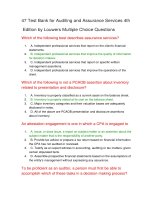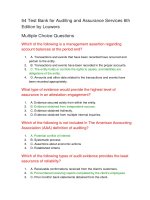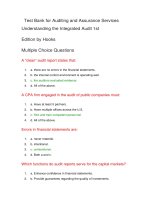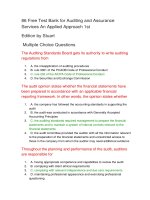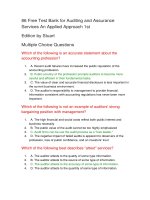Test bank for auditing and assurance services 14th edition
Bạn đang xem bản rút gọn của tài liệu. Xem và tải ngay bản đầy đủ của tài liệu tại đây (123.65 KB, 17 trang )
Test Bank for Auditing and Assurance Services 14th Edition
The Sarbanes-Oxley Act
applies to which of the following companies?
1. A) All companies.
2. B) Privately held companies.
3. C) Public companies.
4. D) All public companies and privately held companies with assets greater
than $500 million.
Recording, classifying, and summarizing economic events in a logical manner
for the purpose of providing financial information for decision making is
commonly called:
1. A) finance.
2. B) auditing.
3. C) accounting.
4. D) economics.
Which department provides quantitative information in order for
management and others to make decisions?
1. A) management information systems.
2. B) auditing.
3. C) finance.
4. D) accounting.
In "auditing" financial accounting data, the primary concern is with:
1. A) determining whether recorded information properly reflects the economic
events that occurred during the accounting period.
2. B) determining if fraud has occurred.
3. C) determining if taxable income has been calculated correctly.
4. D) analyzing the financial information to be sure that it complies with
government requirements.
The trait that distinguishes auditors from accountants is the:
1. A) auditor`s ability to interpret accounting principles generally accepted in
the United States.
2. B) auditor`s education beyond the Bachelor`s degree.
3. C) auditor`s ability to interpret FASB Statements.
4. D) auditor`s accumulation and interpretation of evidence related to a
company`s financial statements.
________ risk reflects the possibility that the information upon which the
business decision was made was inaccurate.
1. A) Client acceptance
2. B) Information
3. C) Business
4. D) Control
The use of the Certified Public Accountant title is regulated by:
1. A) the federal government.
2. B) state law through a licensing department or agency of each state.
3. C) the American Institute of Certified Public Accountants through the licensing
departments of the tax and auditing committees.
4. D) the Securities and Exchange Commission.
Financial statement users often receive unreliable financial information from
companies. Which of the following is not a common reason for this?
1. A) Complex exchange transactions.
2. B) Voluminous data.
3. C) Remoteness of information.
4. D) Each of these choices is a common reason for unreliable financial
information.
An audit of historical financial statements is most often performed to
determine whether the:
1. A) organization is operating efficiently and effectively.
2. B) entity is following specific procedures or rules set down by some higher
authority.
3. C) management team is fulfilling its fiduciary responsibilities to shareholders.
4. D) none of these choices.
In the audit of historical financial statements, what accounting criteria is
most common?
1. A) Regulatory accounting principles.
2. B) International financial reporting standards.
3. C) Generally accepted accounting principles.
4. D) B and C
5. E) All of the above.
Any service that requires a CPA firm to issue a report about the reliability of
an assertion that is made by another party is a(n):
1. A) accounting and bookkeeping service.
2. B) attestation service.
3. C) assurance service.
4. D) tax service.
Three common types of attestation services are:
1. A) audits, reviews, and attestations regarding internal controls.
2. B) audits, verifications, and attestations regarding internal controls.
3. C) reviews, verifications, and attestations regarding internal controls.
4. D) audits, reviews, and verifications.
Which of the following services provides the lowest level of assurance on a
financial statement?
1. A) A review.
2. B) An audit.
3. C) Neither service provides assurance on financial statements.
4. D) Each service provides the same level of assurance on financial statements.
Which of the following is not a SysTrust Services principle as defined by the
AICPA?
1. A) Online privacy.
2. B) Availability.
3. C) Processing integrity.
4. D) Operational integrity.
The Sarbanes-Oxley Act prohibits a CPA firm that audits a public company
from providing which of the following types of services to that company?
1. A) Reviews of quarterly financial statements.
2. B) Preparation of corporate tax returns.
3. C) Most consulting services.
4. D) Tax services.
Attestation services on information technology include WebTrust services and
SysTrust services. Which of the following statements most accurately
describes SysTrust services?
1. A) SysTrust services provide assurance on business processes, transaction
integrity and information processes.
2. B) SysTrust services provide assurance on system reliability in critical areas
such as security and data integrity.
3. C) SysTrust services provide assurance on internal control over financial
reporting.
4. D) SysTrust services provide assurance as to whether accounting personnel
are following procedures prescribed by the company controller.
One objective of an operational audit is to:
1. A) determine whether the financial statements fairly present the entity`s
operations.
2. B) evaluate the feasibility of attaining the entity`s operational objectives.
3. C) make recommendations for improving performance.
4. D) report on the entity`s relative success in attaining profit maximization.
An examination of part of an organization's procedures and methods for the
purpose of evaluating efficiency and effectiveness is what type of audit?
1. A) Operational audit.
2. B) Compliance audit.
3. C) Financial statement audit.
4. D) Production audit.
An audit to determine whether an entity is following specific procedures or
rules set down by some higher authority is classified as a(n):
1. A) audit of financial statements.
2. B) compliance audit.
3. C) operational audit.
4. D) production audit.
Which one of the following is more difficult to evaluate objectively?
1. A) Presentation of financial statements in accordance with generally accepted
accounting principles.
2. B) Compliance with government regulations.
3. C) Efficiency and effectiveness of operations.
4. D) All three of the above are equally difficult.
Which of the following audits can be regarded as generally being a
compliance audit?
1. A) IRS agents` examinations of taxpayer returns.
2. B) GAO auditor`s evaluation of the computer operations of governmental
units.
3. C) An internal auditor`s review of a company`s payroll authorization
procedures.
4. D) A CPA firm`s audit of a public company.
The three requirements for becoming a CPA include all but which of the
following?
1. A) Uniform CPA examination requirement.
2. B) Educational requirements.
3. C) Character requirements.
4. D) Experience requirement.
Which of the following is considered audit evidence?
1. A
2. B
3. C
4. D
Which of the following are required to have a written report regarding the
assertion of another party?
1. A
2. B
3. C
4. D
The criteria by which an auditor evaluates the information under audit may
vary with the information being audited.
1. True
2. False
The criteria used by an external auditor to evaluate published financial
statements are known as generally accepted auditing standards.
1. True
2. False
The Sarbanes-Oxley Act establishes standards related to the audits of
privately held companies.
1. True
2. False
The Sarbanes-Oxley Act is widely viewed as having ushered in sweeping
changes to auditing and financial reporting.
1. True
2. False
Only companies that file annual statements with the Securities and Exchange
Commission are required to have an annual external audit.
1. True
2. False
CPA firms are never allowed to provide bookkeeping services for clients.
1. True
2. False
Section 404 of the Sarbanes-Oxley Act requires public companies to have an
external auditor attest to their internal control over financial reporting.
1. True
2. False
Most public companies' audited financial statements are available on the
SEC's EDGAR database.
1. True
2. False
The primary purpose of a compliance audit is to determine whether the
financial statements are prepared in compliance with generally accepted
accounting principles.
1. True
2. False
Results of compliance audits are typically reported to someone within the
organizational unit being audited rather than to a broad spectrum of outside
users.
1. True
2. False
The primary role of the United States General Accounting Office is the
enforcement of the federal tax laws as defined by Congress and interpreted
by the courts.
1. True
2. False
The Sarbanes-Oxley Act applies to which of the following companies?
1. A) All companies.
2. B) Privately held companies.
3. C) Public companies.
4. D) All public companies and privately held companies with assets greater
than $500 million.
Recording, classifying, and summarizing economic events in a logical manner
for the purpose of providing financial information for decision making is
commonly called:
1. A) finance.
2. B) auditing.
3. C) accounting.
4. D) economics.
Which department provides quantitative information in order for
management and others to make decisions?
1. A) management information systems.
2. B) auditing.
3. C) finance.
4. D) accounting.
In "auditing" financial accounting data, the primary concern is with:
1. A) determining whether recorded information properly reflects the economic
events that occurred during the accounting period.
2. B) determining if fraud has occurred.
3. C) determining if taxable income has been calculated correctly.
4. D) analyzing the financial information to be sure that it complies with
government requirements.
The trait that distinguishes auditors from accountants is the:
1. A) auditor`s ability to interpret accounting principles generally accepted in
the United States.
2. B) auditor`s education beyond the Bachelor`s degree.
3. C) auditor`s ability to interpret FASB Statements.
4. D) auditor`s accumulation and interpretation of evidence related to a
company`s financial statements.
________ risk reflects the possibility that the information upon which the
business decision was made was inaccurate.
1. A) Client acceptance
2. B) Information
3. C) Business
4. D) Control
The use of the Certified Public Accountant title is regulated by:
1. A) the federal government.
2. B) state law through a licensing department or agency of each state.
3. C) the American Institute of Certified Public Accountants through the licensing
departments of the tax and auditing committees.
4. D) the Securities and Exchange Commission.
Financial statement users often receive unreliable financial information from
companies. Which of the following is not a common reason for this?
1. A) Complex exchange transactions.
2. B) Voluminous data.
3. C) Remoteness of information.
4. D) Each of these choices is a common reason for unreliable financial
information.
An audit of historical financial statements is most often performed to
determine whether the:
1. A) organization is operating efficiently and effectively.
2. B) entity is following specific procedures or rules set down by some higher
authority.
3. C) management team is fulfilling its fiduciary responsibilities to shareholders.
4. D) none of these choices.
In the audit of historical financial statements, what accounting criteria is
most common?
1. A) Regulatory accounting principles.
2. B) International financial reporting standards.
3. C) Generally accepted accounting principles.
4. D) B and C
5. E) All of the above.
Any service that requires a CPA firm to issue a report about the reliability of
an assertion that is made by another party is a(n):
1. A) accounting and bookkeeping service.
2. B) attestation service.
3. C) assurance service.
4. D) tax service.
Three common types of attestation services are:
1. A) audits, reviews, and attestations regarding internal controls.
2. B) audits, verifications, and attestations regarding internal controls.
3. C) reviews, verifications, and attestations regarding internal controls.
4. D) audits, reviews, and verifications.
Which of the following services provides the lowest level of assurance on a
financial statement?
1. A) A review.
2. B) An audit.
3. C) Neither service provides assurance on financial statements.
4. D) Each service provides the same level of assurance on financial statements.
Which of the following is not a SysTrust Services principle as defined by the
AICPA?
1. A) Online privacy.
2. B) Availability.
3. C) Processing integrity.
4. D) Operational integrity.
The Sarbanes-Oxley Act prohibits a CPA firm that audits a public company
from providing which of the following types of services to that company?
1. A) Reviews of quarterly financial statements.
2. B) Preparation of corporate tax returns.
3. C) Most consulting services.
4. D) Tax services.
Attestation services on information technology include WebTrust services and
SysTrust services. Which of the following statements most accurately
describes SysTrust services?
1. A) SysTrust services provide assurance on business processes, transaction
integrity and information processes.
2. B) SysTrust services provide assurance on system reliability in critical areas
such as security and data integrity.
3. C) SysTrust services provide assurance on internal control over financial
reporting.
4. D) SysTrust services provide assurance as to whether accounting personnel
are following procedures prescribed by the company controller.
One objective of an operational audit is to:
1. A) determine whether the financial statements fairly present the entity`s
operations.
2. B) evaluate the feasibility of attaining the entity`s operational objectives.
3. C) make recommendations for improving performance.
4. D) report on the entity`s relative success in attaining profit maximization.
An examination of part of an organization's procedures and methods for the
purpose of evaluating efficiency and effectiveness is what type of audit?
1. A) Operational audit.
2. B) Compliance audit.
3. C) Financial statement audit.
4. D) Production audit.
An audit to determine whether an entity is following specific procedures or
rules set down by some higher authority is classified as a(n):
1. A) audit of financial statements.
2. B) compliance audit.
3. C) operational audit.
4. D) production audit.
Which one of the following is more difficult to evaluate objectively?
1. A) Presentation of financial statements in accordance with generally accepted
accounting principles.
2. B) Compliance with government regulations.
3. C) Efficiency and effectiveness of operations.
4. D) All three of the above are equally difficult.
Which of the following audits can be regarded as generally being a
compliance audit?
1. A) IRS agents` examinations of taxpayer returns.
2. B) GAO auditor`s evaluation of the computer operations of governmental
units.
3. C) An internal auditor`s review of a company`s payroll authorization
procedures.
4. D) A CPA firm`s audit of a public company.
The three requirements for becoming a CPA include all but which of the
following?
1. A) Uniform CPA examination requirement.
2. B) Educational requirements.
3. C) Character requirements.
4. D) Experience requirement.
Which of the following is considered audit evidence?
1. A
2. B
3. C
4. D
Which of the following are required to have a written report regarding the
assertion of another party?
1. A
2. B
3. C
4. D


